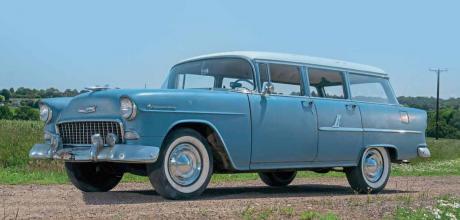1955 Chevrolet Two-Ten Townsman
This 1955 Chevrolet Two-Ten Station Wagon is a wonderfully original example. But as owner Russell Schacter discovered, even the simplest cars sometimes need a little bit of mechanical fettling… Words: Mike Renaut. Photography: Matt Richardson.
Little blue wagon
By the mid-1950s there was a lot of competition for any manufacturer of American cars. In previous years it was common to launch that year’s model with new mechanical parts or new styling – Ford had released their new Y-block V8 in 1954, then introduced a brand new body style for 1955. But now arch rival Chevrolet dared to debut both at once. The 1955 Chevrolet boasted an all-new body with an all-new V8 to haul it, both a result of newly appointed chief engineer Edward Nicholas Cole’s 1952 expansion of the engineering department from 850 to 2900 people in order to “turn Chevrolet around”.

The brand new Turbo Fire 265 V8 was almost developed as a V6 since one had been created by General Motors in 1947, but Cole dismissed it as lacking power. Also rejected was a 230cu in version of the 1949 Cadillac V8 Cole had previously designed. With deadlines looming, Cole had just 15 weeks to come up with a completely new engine. He started with five main bearings and a desire for a 265cu in displacement – which dictated a 3.00- by 3.75-inch bore and stroke. The lightweight design included hollow pushrods and valve guides integral with the die-cast heads. New casting techniques meant unheard-of precision and, along with many other innovations, resulted in a V8 that was 40lb lighter and 30% more powerful than the existing V6.
Gone too was the dullness of the previous cars. More than ever, Chevrolets now resembled high-priced Cadillacs with their hooded headlights, wraparound windscreen, Contour Cut dip styling in the rear quarters and smart, finned tail-lights. Work had begun on styling in June 1952 and although the 1955 model was actually an inch shorter than the ‘54s, it looked much longer, thanks to a bonnet level with the height of the front wings and fully flush rear wings. One sticking point was the Ferrari-esque crate grille. Management hated it, as did some dealers who found it a hard sell against the full-width-grilled Fords and Plymouths, but vice-president Harley Earl insisted it remain. Management would get their way for 1956… Other innovations included push-button door handles, tubeless tyres, 12-volt electrics, suspended brake and clutch pedals, and ‘spherical-joint’ front suspension (since Ford’s was already called ‘ball-joint’). The new chassis frame was 18% lighter, yet 50% stiffer.
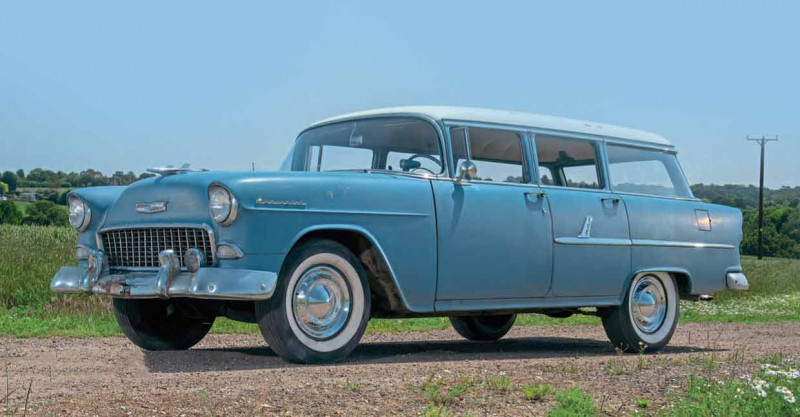
For 1955, you could have your Chevrolet in the top-range Bel Air, mid-range Two-Ten or base model One-Fifty. The Two-Tens comprised a pillarless sport coupe, four-door sedan, two-door sedan and Del Ray Club Coupe (which was also a sedan) and a pair of wagons, the Townsman featured here and a two-door Handyman. Most exciting of all was the stylish new two-door Bel Air Nomad wagon with unique rear wheel arches, inspired by a Corvette-based styling exercise. Incidentally, there wasn’t a four-door wagon in the One-Fifty series, but the Bel Air version was called the Beauville.
Have it your way
Wagons came in a choice of four colours – Neptune Green, Glacier Blue, Shoreline Beige or Autumn Bronze – with two-tone options and one of four two-tone vinyl interiors. You could specify up to 53 accessories including heater/defroster, reversing lamps, power steering and/or brakes, three different radios, interior sun visors and even an electric shaver ‘for use in car or home’.
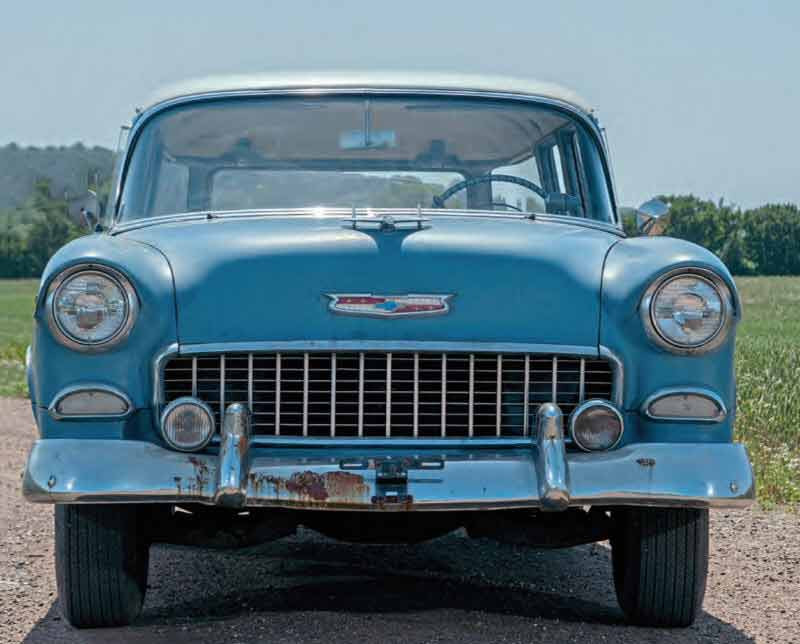
The existing 235cu in straight-six could be fitted in any model, as could the new V8. Both offered a choice of two horsepower ratings, along with an optional (except wagons) performance Power Pack for the V8. A three-speed manual was standard with optional Borg Warner Touch Down overdrive or two-speed Powerglide automatic.
The Two-Ten was essentially a One-Fifty with more sparkle; it got slightly more stainless trim inside and out and better appointed interiors. Although Motor Trend magazine found the 1955 Chevrolet’s ride a little hard, they still named it (and the Mercury) the year’s top handler.
Indeed, reviews were almost entirely favourable. Mechanix Illustrated called the Chevrolet “glamorous” and a “junior-sized Olds with Buick doors and a Cadillac rear”, while Motor Trend managed 0-60mph in 11.4 seconds and a top speed of 108mph.
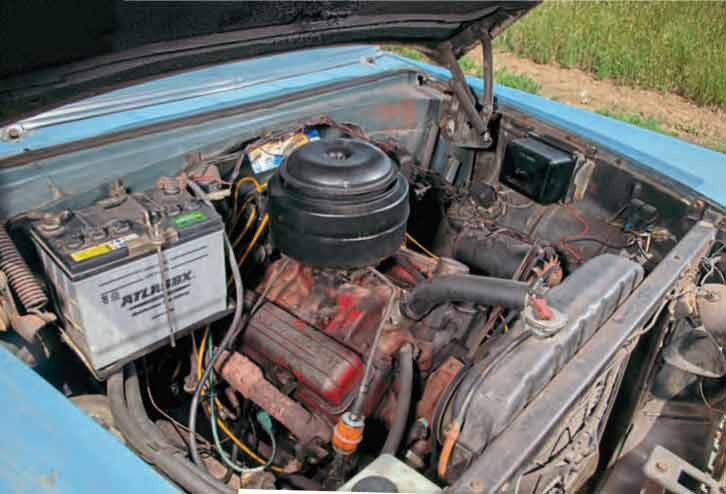
It all added up to a huge success for Chevy who captured an astonishing 44% of the low-priced market. General Motors built their 50 millionth car in November 1954 − a gold ‘55 Chevy – and of the 7.1 million American cars sold in 1955, 24% were Chevrolets.
Our featured 1955 Two-Ten wagon would have cost $2127 new and is one of 82,303 sold that year. Going by the VIN, this example was built in Oakland, California, but otherwise we know little of the car’s history. The Chevy belongs to Russell Schacter, of American Dreams (0800 848 8032/www.americandreams.co.uk), the ‘55 being one of his collection of vehicles that can be rented for functions and filming work.
Eastern promise
“I bought it from a Japanese auction site,” explains Russell. “I subscribe to various ones around the world. Apparently there are a number of American cars over there because they’re seen as being very exotic. In my experience Japanese sellers don’t embellish things; they state facts and give you a full report on the condition of the car. I dealt with an agent in Japan and he gave me a price that included shipping to the UK.
Danchuk sticker copies original badge. Plenty of patina on this wagon. Auxiliary gauges. Still a working wagon, 66 years later. Door cards could do with a change.
All-seeing Eye
One interesting option fitted on our feature car is a dashboard-mounted Autronic Eye. Introduced in 1952 for Oldsmobile and Cadillac, then other divisions from 1953, a light-sensing phototube detected oncoming light and signalled an amplifier to switch the headlamps from main to dipped beam. Chevrolets up to 1954 required a specific 12 to six-volt resister.
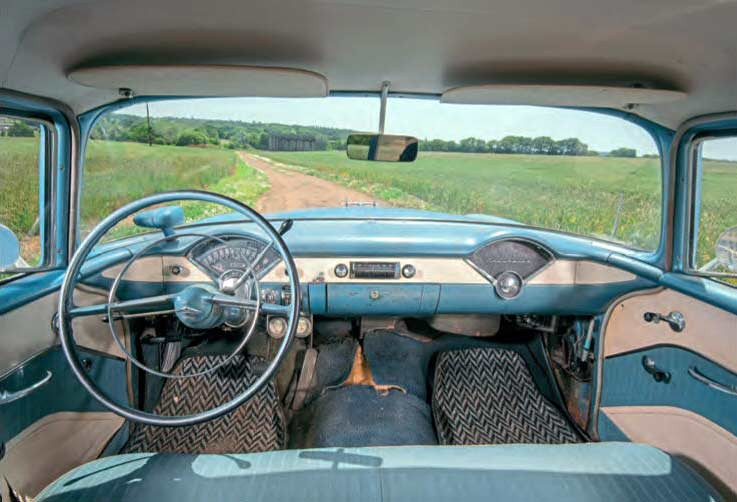
It worked well on a completely dark road, but the introduction of street lighting and reflective road signs often sent early units crazy, leading to headlights rapidly flashing on and off. Controls were introduced for adjustment. Then, in 1960, the name changed to Guide-Matic and used an amber lens for less sensitivity to fog or snow. From 1964, Cadillac versions were installed behind the front wing or grille, which helped greatly. Modern versions are still in use today, such as Cadillac’s Intellibeam.
Radio speaker mirrors speedo. Access is easy. 1955 Chevrolet Sedan Delivery.… was all new. ’55 Chevy wagon…
That's what you call a ‘working’ engine! Russell Schacter. Prehensile fins make an appearance


